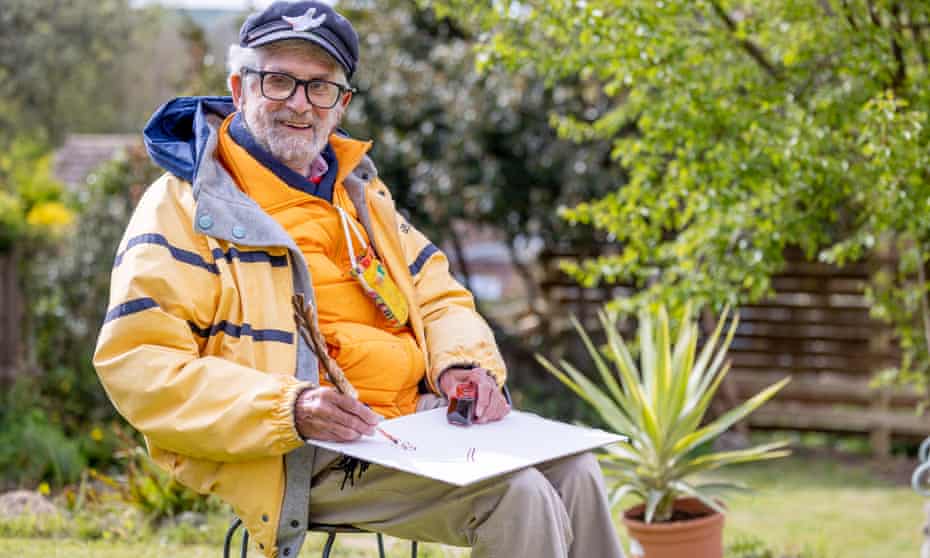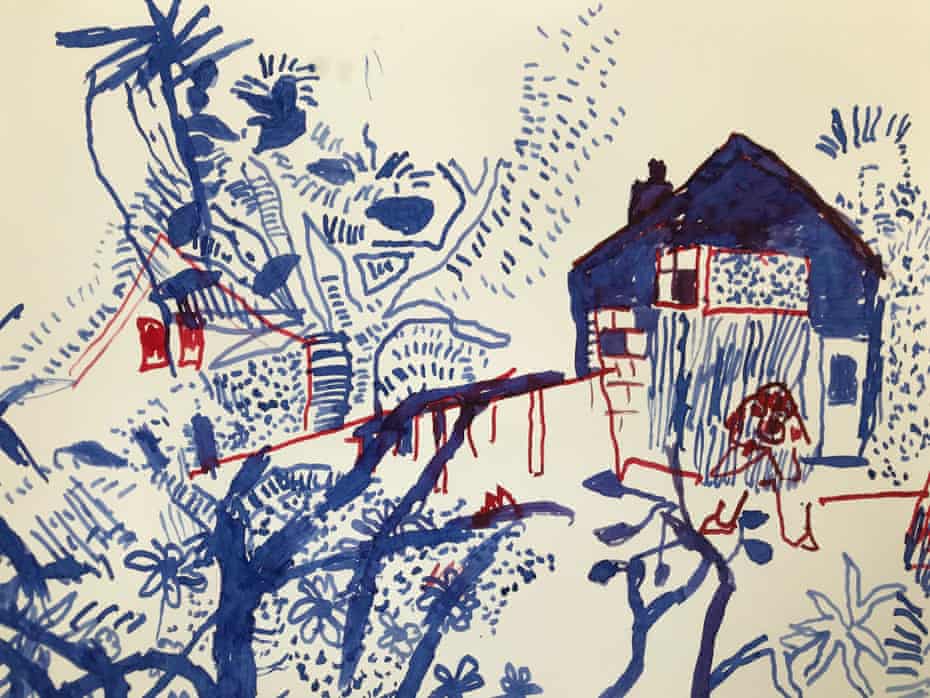Clutching a quill and pots of ink, Philip Sutton ended his 421-day care home lockdown this week by heading out to do what has been impossible since the Covid pandemic began: observe something new and capture it on paper.
The 92-year-old Royal Academician, who built a reputation as one of Britain’s most celebrated colourist painters, has been confined to Harbour House, a Quaker care home in Dorset, since 9 March 2020 under government guidelines to protect vulnerable people.
Policies discouraging care home residents from going out have led to desperate complaints that people were in effect being imprisoned even as infection rates fell. And the rules have denied Sutton fresh landscapes, his regular long beach walks and the joy of unexpected encounters. But this week, he, and hundreds of thousands of others, were finally released from the longest of lockdowns.
To mark the occasion his daughter Saskia laid on a strawberry cream tea in her garden where, under blue skies, Sutton started to draw the trees, houses and flowers in front of him. The spirited sketch in blue and red ink marked the end of 14 months of isolation. A “terrible year”, which was often “lonely”, was over.
“I am against moaning,” he told the Guardian, adding: “I don’t like to admit how difficult it was because it would depress me.”
Freedom, on the other hand, felt “amazing – unbelievable”, he said.
“If you imagine you’re a prisoner and you were expecting another six months [inside] and then someone says, ‘the door’s open, you can go out’, that’s how it felt,” said his other daughter Imogen. “We were both physically fizzing with it.”
This week’s lifting of restrictions on visits out of care homes has seen similar bubbles of happiness popping across the country. After the threat of legal action by residents’ rights campaigners, Boris Johnson announced last Friday that care residents would no longer have to self-isolate for 14 days after going out.

Barbara Bailey, 91, made her first trip out of the Rose Lawn care home in Sidmouth in Devon since February 2020, on Tuesday. She headed to the seafront with a carer and watched squirrels scamper in a churchyard.
“It felt wonderful,” she said. “We were singing all the way up the high street – Frank Sinatra songs, whatever we could think of.”
But for others the unlocking has exposed the sadder reality that isolation has caused damage. In North Yorkshire, Mike Thompson, who used to enjoy walking for miles with his wife, Ann, is now confined to a wheelchair owing to being sedentary for so long.
“He used to be a fell walker and rock climber and in February 2020 he could walk for miles,” she said.
Despite the new guidance, many relatives are also still trying to negotiate access, said Helen Wildbore, director of the Relatives & Residents Association.
“We hear the word prison too often on our helpline,” she said. “People feel they live in an institution, not a home. It has not been a temporary extreme measure, it has become a new reality.”
Sutton, who studied at the Slade School of Art and sold paintings to the Tate and UK government collections, said he realised early in the lockdown that he needed to engage his imagination “otherwise I was going to go pop”.
He paced the care home garden path but imagined he was strolling through a Japanese zen garden. He “invited in a whole load of tropical birds [and] spent three to four months painting them”.
“They made an awful mess in my room,” he said. “They are very difficult house guests.”

But they too were conjured from his imagination. He was inspired by a fig tree in a neighbour’s garden and followed up with a series of paintings. The fig, his daughter later explained, was a favourite plant of his wife, who died a few years ago.
“It’s been hard on the residents of Harbour House to be locked in,” he said. “We all suffered from not seeing our relatives and friends and just using the telephone. It has been a very, very difficult time.”
About 35,000 people died with Covid in UK care homes and their unlocking has happened more slowly that the rest of society. Many insurers will not underwrite the risks of Covid, leading to high levels of caution among operators worried about reseeding infection. Some say they are under pressure to limit risks from public commissioning authorities that fund care places. Meanwhile, families groups have criticised some operators for failing to try hard enough to facilitate visits, despite low community infection rates.
The Care Quality Commission regulator said this week it had recently found 30 cases of blanket bans on visits into care homes despite government guidelines saying residents should be allowed two designated visitors.
John’s Campaign, which lobbies for visiting rights, is also threatening legal action against the government if the 14-day self-isolation period is not waived after overnight stays with relatives or attending hospital appointments.
But for those like the Suttons who have been able to gather again, it has been a good week.
“It’s fantastic to see Dad’s pleasure and happiness,” said Imogen Sutton. “It’s rather wonderful that it happened at the beginning of May. The blossom’s out, the sun’s out and the birds are singing. It’s like we’re starting to live again.”
Additional reporting by Molly Blackall
This content first appear on the guardian
